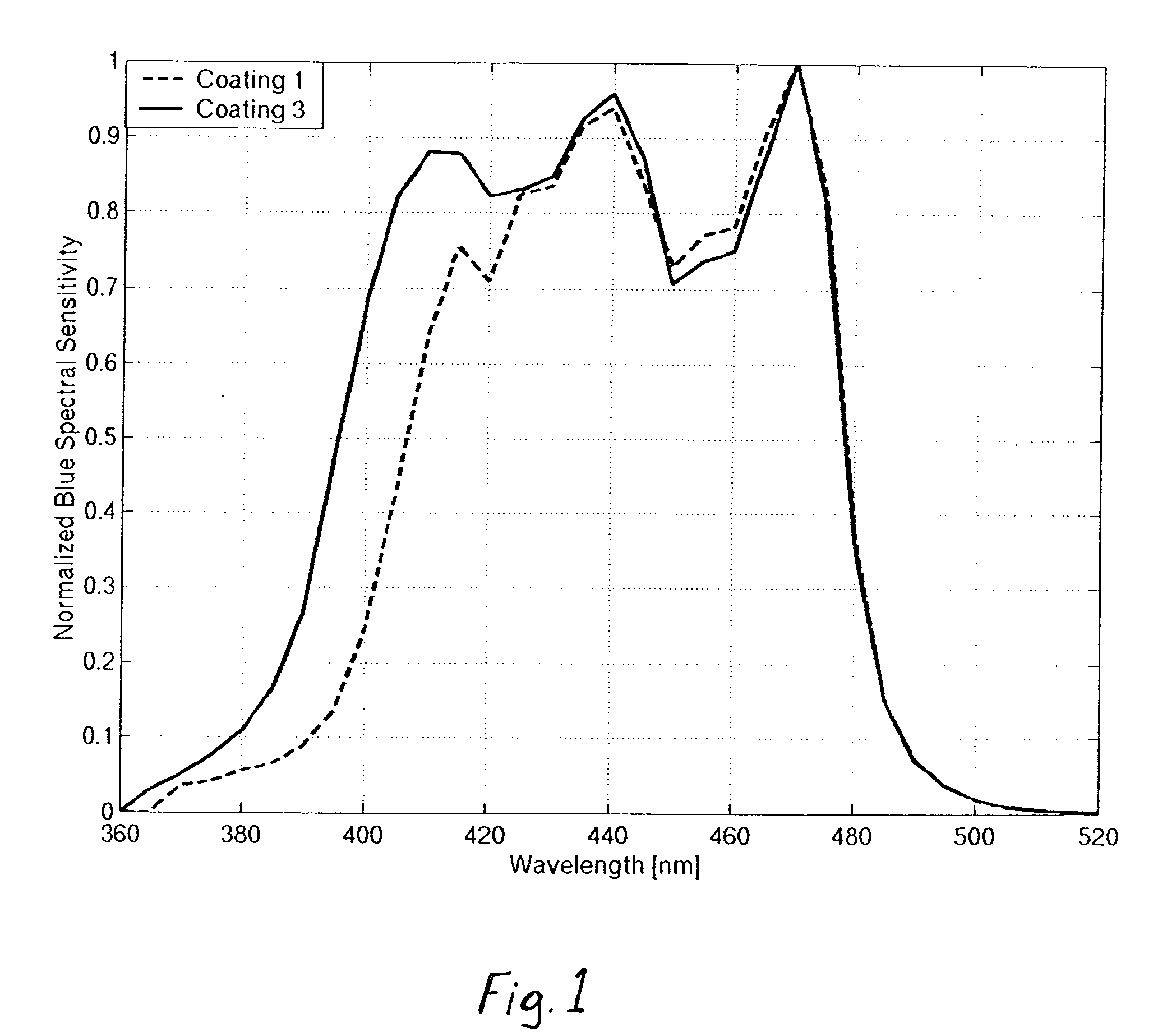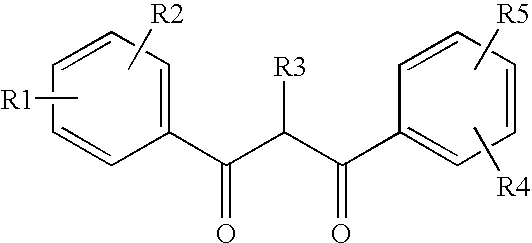Color photographic element with UV absorber
- Summary
- Abstract
- Description
- Claims
- Application Information
AI Technical Summary
Benefits of technology
Problems solved by technology
Method used
Image
Examples
example 1
[0091]112.5 g of UV Dye-1 and 112.5 g of UV Dye-2 and 22.5 g of Chem-1 was dissolved in 157.5 g of tri-cresyl phosphate. This oil phase solution was then added to an aqueous phase solution consisting of 300.0 g Type IV gelatin, 180.0 g of a 10 wt % solution of Alkanol XC (Dupont), 4.3 g of a 0.7 wt % solution of Kathon LX (Rohm & Haas), 36.0 g of 9.24 wt % sulfuric acid and 2074.7 g of distilled water. This mixture was pre-mixed using a Brinkman rotor-stator device at 5000 rpm for 2 min at 80° C. and then passed one time through a Crepaco homogenizer at 5000 psi at 80° C. to form Dispersion A, which consisted of 3.75% UV Dye-1 and 3.75% UV Dye-2 and 10.0% gel. Dispersion B was similarly prepared except that it employed 112.5 g UV Dye-3 in place of UV Dye-1.
[0092]Dispersion A was coated in Layers 1 and 12 of the multilayer film structure given below as Coating 1. Additional experimental coating variations are described in Table I.
[0093]
MULTILAYER FILM STRUCTURE: COATING 1mg / sqmeterLa...
example 2
[0099]Comparison Coating 1 of Example 1 exhibits a blue spectral sensitivity that is typical of commercially available films, as illustrated in FIG. 1. This blue spectral sensitivity has a height at 400 nm which is approximately 24 percent of the maximum blue spectral sensitivity, while the area under the blue spectral sensitivity curve for wavelengths above 420 nm is approximately 79 percent of the total area under the curve for wavelengths above 360 nm. While other commercially available films may provide higher relative sensitivity at 400 nm, those that do will also generally provide significantly lower percentages of overall blue sensitivity accounted for by wavelengths above 420 nm, and no commercially available element is known which provides a blue spectral sensitivity curve for the element having a height at 400 nm which is at least 63% of the maximum blue spectral sensitivity, and wherein the area under the blue spectral sensitivity curve for wavelengths above 420 nm is at ...
example 3
[0102]Dispersions C and D were prepared with the same formulation as Dispersions A and B, respectively. These dispersions were coated in Layers 1 and 12 of the multilayer film structure given above as described in Table II.
[0103]
TABLE IIMultilayer Color Negative Film Variations (coated levels in mg / m2)BlueDis-ShortLongAgBlueCoatingpersionUVUVUV DyeLev-BlueCon-NoIDDyeDyeLevels*elsSpeedtrast5 (Comp)CUVUV10513603400.675Dye-2Dye-16 (Comp)CUVUV10513603400.674Dye-2Dye-17 (Inv)DUVUV10513603470.700Dye-2Dye-38 (Comp)CUVUV10513603400.675Dye-2Dye-1*Layer 12 only
[0104]Coating 7, in which the UV absorber of the present invention (UV Dye-3) was substituted for UV Dye-1, exhibits significantly increased blue speed and blue contrast relative to comparison Coatings 5, 6 and 8, with no significant adverse effects on color reproduction.
PUM
 Login to View More
Login to View More Abstract
Description
Claims
Application Information
 Login to View More
Login to View More - R&D
- Intellectual Property
- Life Sciences
- Materials
- Tech Scout
- Unparalleled Data Quality
- Higher Quality Content
- 60% Fewer Hallucinations
Browse by: Latest US Patents, China's latest patents, Technical Efficacy Thesaurus, Application Domain, Technology Topic, Popular Technical Reports.
© 2025 PatSnap. All rights reserved.Legal|Privacy policy|Modern Slavery Act Transparency Statement|Sitemap|About US| Contact US: help@patsnap.com



